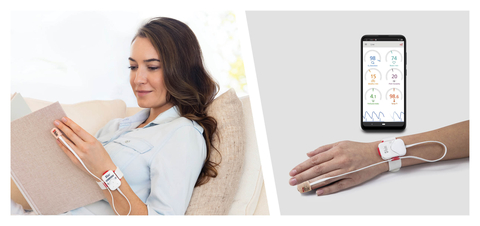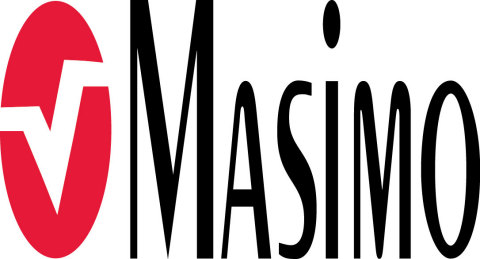Two-part Study Finds That Remote Patient Monitoring with Masimo SafetyNet® Reduced Length of Hospital Stay for COVID-19 Patients
Two-part Study Finds That Remote Patient Monitoring with Masimo SafetyNet® Reduced Length of Hospital Stay for COVID-19 Patients
New Study Evaluates Masimo SafetyNet in Helping Patients Recover at Home
IRVINE, Calif.--(BUSINESS WIRE)--Masimo (NASDAQ: MASI) today announced the findings of a two-part retrospective study published in Telemedicine and e-Health in which Dr. Hemali Patel and colleagues at the University of Colorado and UC Health (UCH) in Aurora, Colorado evaluated the impact of remote patient monitoring (RPM) of COVID-19 patients using Masimo SafetyNet® on hospital length of stay (LOS). Masimo SafetyNet, a remote patient management and telehealth solution, uses tetherless Masimo Radius PPG™ SET® pulse oximetry and a smartphone app to seamlessly transmit continuous home-based patient monitoring data to hospital clinicians. The researchers found a significant association between briefer hospitalization and patients discharged with Masimo SafetyNet and without home oxygen, concluding that “Home telemonitoring after discharge for patients with COVID-19 may be a safe tool that may reduce the mean duration of hospitalization and create more bed capacity.”1
Noting the rising demand for acute care and hospital bed space during the COVID-19 pandemic, the researchers sought to evaluate whether use of a home telemonitoring system could help to optimize care—including earlier discharge from the hospital—for patients with or suspected to have COVID-19 while ensuring the “sustainability of health care capacity and resources” for those with more urgent needs, as well as decreasing usage of personal protective material, reducing pressure on personnel, and minimizing the risk of viral transmission. From March to June 2020, during the first COVID-19 surge at UCH, they implemented an RPM feasibility program with Masimo SafetyNet (study phase 1), which they redeployed during their second surge, October 2020 to February 2021 (study phase 2). Using Masimo SafetyNet with Radius PPG allowed them to remotely monitor oxygen saturation (SpO2), pulse rate, and plethysmographic respiration rate (Masimo RRp®) from a continuously staffed virtual health center, with data transmitted via Masimo’s HIPAA-compliant secure cloud service.
Retrospectively, the researchers reviewed data for all patients discharged home after an admission for COVID-19 over the two periods. Patients discharged with and without Masimo SafetyNet were compared using a two-to-one-matched case-control design, with patients matched in each time period based on age, sex, Charlson comorbidity index, and limited English proficiency. The primary outcome was hospital LOS, and secondary outcomes were a) 7-, 14-, and 30-day hospital readmission and b) return to the emergency department within 30 days. Hypothesizing that the association between LOS and use of Masimo SafetyNet might vary according to whether patients were discharged with home oxygen therapy, they also included an interaction term for the therapy in their statistical analysis. In total, they enrolled 923 patients in phase 1 (78 discharged with Masimo SafetyNet, 845 without) and 1056 patients in phase 2 (125 discharged with Masimo SafetyNet, 931 without).
The researchers found that there was a decrease in LOS for patients discharged with Masimo SafetyNet, without an increase in 30-day ED revisits or hospital readmission (from 9.1 ± 12.4 days to 7.5 ± 5.5 days in phase 1, p=0.2721; from 6.4 ± 6.4 days to 6.1 ± 5.6 days in phase 2, p=0.6913). While there was not a significant association compared to patients discharged without Masimo SafetyNet, they describe the decrease as a “trend toward an overall lower LOS.” However, as hypothesized, they observed an interaction effect between Masimo SafetyNet and home oxygen therapy: in phase 2, a decrease in LOS was strongly associated with Masimo SafetyNet patients discharged without home oxygen therapy, compared to non-Masimo SafetyNet patients—LOS decreased by an additional 36%. No other significant interactions were detected.
In their discussion, the researchers note that their study supports other work suggesting that home telemonitoring may allow for earlier hospital discharge, especially as “any reduction in length of hospitalization makes more beds available for patients.” They did not find a strong association between reduction in LOS and patients discharged with Masimo SafetyNet and with oxygen therapy, which they believe makes sense “because hypoxia portends a poorer prognosis and often a longer hospitalization.”
The authors concluded, “Our results remain relevant as we face yet more surges of admissions of patients with COVID-19. Even if the surges decrease, we face hospital capacity difficulties as we navigate ongoing COVID-19 admissions in addition to providing care for non-COVID patients. Home telemonitoring after discharge for patients with COVID-19 may be a safe tool that may reduce the mean duration of hospitalization and create more bed capacity.”
@Masimo | #Masimo
About Masimo
Masimo (NASDAQ: MASI) is a global medical technology company that develops and produces a wide array of industry-leading monitoring technologies, including innovative measurements, sensors, patient monitors, and automation and connectivity solutions. Our mission is to improve patient outcomes and reduce the cost of care. Masimo SET® Measure-through Motion and Low Perfusion™ pulse oximetry, introduced in 1995, has been shown in over 100 independent and objective studies to outperform other pulse oximetry technologies.2 Masimo SET® has also been shown to help clinicians reduce severe retinopathy of prematurity in neonates,3 improve CCHD screening in newborns,4 and, when used for continuous monitoring with Masimo Patient SafetyNet™ in post-surgical wards, reduce rapid response team activations, ICU transfers, and costs.5-8 Masimo SET® is estimated to be used on more than 200 million patients in leading hospitals and other healthcare settings around the world,9 and is the primary pulse oximetry at 9 of the top 10 hospitals as ranked in the 2021-22 U.S. News and World Report Best Hospitals Honor Roll.10 Masimo continues to refine SET® and in 2018, announced that SpO2 accuracy on RD SET® sensors during conditions of motion has been significantly improved, providing clinicians with even greater confidence that the SpO2 values they rely on accurately reflect a patient’s physiological status. In 2005, Masimo introduced rainbow® Pulse CO-Oximetry technology, allowing noninvasive and continuous monitoring of blood constituents that previously could only be measured invasively, including total hemoglobin (SpHb®), oxygen content (SpOC™), carboxyhemoglobin (SpCO®), methemoglobin (SpMet®), Pleth Variability Index (PVi®), RPVi™ (rainbow® PVi), and Oxygen Reserve Index (ORi™). In 2013, Masimo introduced the Root® Patient Monitoring and Connectivity Platform, built from the ground up to be as flexible and expandable as possible to facilitate the addition of other Masimo and third-party monitoring technologies; key Masimo additions include Next Generation SedLine® Brain Function Monitoring, O3® Regional Oximetry, and ISA™ Capnography with NomoLine® sampling lines. Masimo’s family of continuous and spot-check monitoring Pulse CO-Oximeters® includes devices designed for use in a variety of clinical and non-clinical scenarios, including tetherless, wearable technology, such as Radius-7® and Radius PPG™, portable devices like Rad-67®, fingertip pulse oximeters like MightySat® Rx, and devices available for use both in the hospital and at home, such as Rad-97®. Masimo hospital automation and connectivity solutions are centered around the Masimo Hospital Automation™ platform, and include Iris® Gateway, iSirona™, Patient SafetyNet, Replica®, Halo ION™, UniView®, UniView :60™, and Masimo SafetyNet®. In 2022, Masimo acquired Sound United, a leading developer of premium consumer sound and home integration technologies, whose brands include Bowers & Wilkins®, Denon®, Polk Audio®, Marantz®, Definitive Technology®, Classé®, and Boston Acoustics®. Additional information about Masimo and its products may be found at www.masimo.com. Published clinical studies on Masimo products can be found at www.masimo.com/evidence/featured-studies/feature/.
ORi and RPVi have not received FDA 510(k) clearance and are not available for sale in the United States. The use of the trademark Patient SafetyNet is under license from University HealthSystem Consortium.
References
- Patel H, Hassell, A, Keniston A, Davis C. Impact of Remote Patient Monitoring on Length of Stay for Patients with COVID-19. Telemedicine and E-Health. 2022. DOI: 10.1089/tmj.2021.0510.
- Published clinical studies on pulse oximetry and the benefits of Masimo SET® can be found on our website at http://www.masimo.com. Comparative studies include independent and objective studies which are comprised of abstracts presented at scientific meetings and peer-reviewed journal articles.
- Castillo A et al. Prevention of Retinopathy of Prematurity in Preterm Infants through Changes in Clinical Practice and SpO2 Technology. Acta Paediatr. 2011 Feb;100(2):188-92.
- de-Wahl Granelli A et al. Impact of pulse oximetry screening on the detection of duct dependent congenital heart disease: a Swedish prospective screening study in 39,821 newborns. BMJ. 2009;Jan 8;338.
- Taenzer A et al. Impact of pulse oximetry surveillance on rescue events and intensive care unit transfers: a before-and-after concurrence study. Anesthesiology. 2010:112(2):282-287.
- Taenzer A et al. Postoperative Monitoring – The Dartmouth Experience. Anesthesia Patient Safety Foundation Newsletter. Spring-Summer 2012.
- McGrath S et al. Surveillance Monitoring Management for General Care Units: Strategy, Design, and Implementation. The Joint Commission Journal on Quality and Patient Safety. 2016 Jul;42(7):293-302.
- McGrath S et al. Inpatient Respiratory Arrest Associated With Sedative and Analgesic Medications: Impact of Continuous Monitoring on Patient Mortality and Severe Morbidity. J Patient Saf. 2020 14 Mar. DOI: 10.1097/PTS.0000000000000696.
- Estimate: Masimo data on file.
- http://health.usnews.com/health-care/best-hospitals/articles/best-hospitals-honor-roll-and-overview.
Forward-Looking Statements
This press release includes forward-looking statements as defined in Section 27A of the Securities Act of 1933 and Section 21E of the Securities Exchange Act of 1934, in connection with the Private Securities Litigation Reform Act of 1995. These forward-looking statements include, among others, statements regarding the potential effectiveness of Masimo SafetyNet®, Radius PPG™, and SET®. These forward-looking statements are based on current expectations about future events affecting us and are subject to risks and uncertainties, all of which are difficult to predict and many of which are beyond our control and could cause our actual results to differ materially and adversely from those expressed in our forward-looking statements as a result of various risk factors, including, but not limited to: risks related to our assumptions regarding the repeatability of clinical results; risks related to our belief that Masimo's unique technologies, including Masimo Safety, Radius PPG, and SET®, contribute to positive clinical outcomes and patient safety; risks that the researchers’ conclusions and findings may be inaccurate; risks related to our belief that Masimo noninvasive medical breakthroughs provide cost-effective solutions and unique advantages; risks related to COVID-19; as well as other factors discussed in the "Risk Factors" section of our most recent reports filed with the Securities and Exchange Commission ("SEC"), which may be obtained for free at the SEC's website at www.sec.gov. Although we believe that the expectations reflected in our forward-looking statements are reasonable, we do not know whether our expectations will prove correct. All forward-looking statements included in this press release are expressly qualified in their entirety by the foregoing cautionary statements. You are cautioned not to place undue reliance on these forward-looking statements, which speak only as of today's date. We do not undertake any obligation to update, amend or clarify these statements or the "Risk Factors" contained in our most recent reports filed with the SEC, whether as a result of new information, future events or otherwise, except as may be required under the applicable securities laws.
Contacts
Media Contact:
Masimo
Evan Lamb
949-396-3376
elamb@masimo.com

